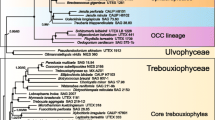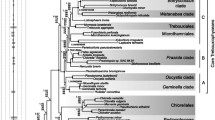Abstract
Chromera velia is a newly discovered photosynthetic eukaryotic alga that has functional chloroplasts closely related to the apicoplast of apicomplexan parasites. Recently, the chloroplast in C. velia was shown to be derived from the red algal lineage. Light-harvesting protein complexes (LHC), which are a group of proteins involved in photon capture and energy transfer in photosynthesis, are important for photosynthesis efficiency, photo-adaptation/accumulation and photo-protection. Although these proteins are encoded by genes located in the nucleus, LHC peptides migrate and function in the chloroplast, hence the LHC may have a different evolutionary history compared to chloroplast evolution. Here, we compare the phylogenetic relationship of the C. velia LHCs to LHCs from other photosynthetic organisms. Twenty-three LHC homologues retrieved from C. velia EST sequences were aligned according to their conserved regions. The C. velia LHCs are positioned in four separate groups on trees constructed by neighbour-joining, maximum likelihood and Bayesian methods. A major group of seventeen LHCs from C. velia formed a separate cluster that was closest to dinoflagellate LHC, and to LHC and fucoxanthin chlorophyll-binding proteins from diatoms. One C. velia LHC sequence grouped with LI1818/LI818-like proteins, which were recently identified as environmental stress-induced protein complexes. Only three LHC homologues from C. velia grouped with the LHCs from red algae.



Similar content being viewed by others
Abbreviations
- Chl:
-
Chlorophyll
- FCP:
-
Fucoxanthin chlorophyll-binding protein
- LHC:
-
Light-harvesting protein complexes
- LHCI:
-
Light-harvesting complexes bound to photosystem I
- LHCII:
-
Light-harvesting complexes bound to photosystem II
- MgDVP:
-
Magnesium divinyl pheoporphyrin a5 monomethyl ester
- ML:
-
Maximum likelihood
- MSR:
-
Membrane-spanning regions
- PS:
-
Photosystems
References
Archibald JM (2009) The puzzle of plastid evolution. Curr Biol 19:R81–R88
Barros T, Kühlbrandt W (2009) Crystallisation, structure and function of plant light-harvesting complex II. Biochim Biophys Acta Bioenerg 1787:753–772
Blankenship RE (2002) Molecular mechanisms of photosynthesis. Blackwell Science, Oxford
Cavalier-Smith T (1999) Principles of protein and lipid targeting in secondary symbiogenesis: euglenoid, dinoflagellate, and sporozoan plastid origins and the eukaryote family tree. J Eukaryot Microbiol 46:347–366
Cole C, Barber JD, Barton GJ (2008) The Jpred 3 secondary structure prediction server. Nucl Acids Res 36:W197–W201
Dittami SM, Michel G, Collen J, Boyen C, Tonon T (2010) Chlorophyll-binding protein revisited—a multigenic family of light-harvesting and stress protein from a brown algal perspective. BMC Evol Biol 10:365
Durnford DG, Deane JA, Tan S, McFadden GI, Gantt E, Green BR (1999) A phylogenetic assessment of the eukaryotic light-harvesting antenna proteins, with implications for plastid evolution. J Mol Evol 48:59–68
Flachmann R, Kühlbrandt W (1996) Crystallization and identification of an assembly defect of recombinant antenna complexes produced in transgenic tobacco plants. Proc Natl Acad Sci USA 93:14966–14971
Gantt E, Grabowski B, Cunningham FX Jr (2003) Antenna systems of red algae: phycobilisomes with photosdystem II and chlorophyll complexes with photosystem I. In: Green BR, Parson WW (eds) Light-harvesting antennas in photosynthesis. Kluwer Academic Publisher, Dordrecht, pp 307–322
Green BR (2003) The Evolution of light-harvesting antennas. In: Green BR, Parson WW (eds) Light-harvesting antennas in photosynthesis. Kluwer Academic Publisher, Dordrecht, pp 129–168
Green BR (2007) The evolution of light-harvesting antennas. In: Falkowski PG, Knoll AH (eds) Evolution of primary producers in the sea. Elsevier, Burlington, pp 37–53
Green BR (2011) After the primary endosymbiosis: an update on the chromalveolate hypothesis and the origins of algae with Chl c. Photosynth Res 107:103–115
Green BR, Durnford DG (1996) The chlorophyll-carotenoid proteins of oxygenic photosynthesis. Annu Rev Plant Physiol Plant Mol Biol 47:685–714
Green BR, Kühlbrandt W (1995) Sequence conservation of light-harvesting and stress-response proteins in relation to the 3-dimensional molecular-structure of LHCII. Photosynth Res 44:139–148
Green BR, Pichersky E (1994) Hypothesis for the evolution of 3-helix Chl a/b and Chl a/c light-harvesting antenna proteins from 2-helix and 4-helix ancestors. Photosynth Res 39:149–162
Guindon S, Dufayard JF, Lefort V, Anisimova M, Hordijk W, Gascuel O (2010) New algorithms and methods to estimate maximum-likelihood phylogenies: assessing the performance of PhyML 3.0. Syst Biol 59:307–321
Hiller RG, Broughton MJ, Wrench PM, Sharples FP, Miller DJ, Catmull J (1999) Dinoflagellate light-harvesting proteins: genes, structure and reconstitution. In: Argyroudi-Akoyunoglou JH, Senger H (eds) Chloroplast from molecular biology to biotechnology. Nato Advanced Science Institute series, sub-series 3, high technology, vol 46. Springer, Dordrecht, pp 3–10
Hoober JK, Eggink LL (1999) Assembly of light-harvesting complex II and biogenesis of thylakoid membranes in chloroplasts. Photosynth Res 61:197–215
Janouskovec J, Horak A, Obornik M, Lukes J, Keeling PJ (2010) A common red algal origin of the apicomplexan, dinoflagellate, and heterokont plastids. Proc Natl Acad Sci USA 107:10949–10954
Jansson S (1999) A guide to the Lhc genes and their relatives in Arabidopsis. Trends Plant Sci 4:236–240
Koziol AG, Borza T, Ishida KI, Keeling P, Lee RW, Durnford DG (2007) Tracing the evolution of the light-harvesting antennae in chlorophyll a/b-containing organisms. Plant Physiol 143:1802–1816
Kühlbrandt W, Wang DN, Fujiyoshi Y (1994) Atomic model of plant light-harvesting complex by electron crystallography. Nature 367:614–621
LaRoche J, Henry D, Wyman K, Sukenik A, Falkowski P (1994) Cloning and nucleotide-sequence of a cDNA-encoding a major fucoxanthin, chlorophyll a/c-containing protein from the chrysophyte Isochrysis galbana—implications for evolution of the cab gene family. Plant Mol Biol 25:355–368
Lepetit B, Volke D, Gilbert M, Wilhelm C, Goss R (2010) Evidence for the existence of one antenna-associated, lipid-dissolved and two protein-bound pools of diadinoxanthin cycle pigments in diatoms. Plant Physiol 154:1905–1920
Lim L, McFadden GI (2010) The evolution, metabolism and functions of the apicoplast. Philos Trans R Soc B Biol Sci 365:749–763
Liu ZF, Yan HC, Wang KB, Kuang TY, Zhang JP, Gui LL, An XM, Chang WR (2004) Crystal structure of spinach major light-harvesting complex at 2.72 angstrom resolution. Nature 428:287–292
Moore RB, Obornik M, Janouskovec J, Chrudimsky T, Vancova M, Green DH, Wright SW, Davies NW, Bolch CJS, Heimann K, Slapeta J, Hoegh-Guldberg O, Logsdon JM, Carter DA (2008) A photosynthetic alveolate closely related to apicomplexan parasites. Nature 451:959–963
Moseley JL, Chang CW, Grossman AR (2006) Genome-based approaches to understanding phosphorus deprivation responses and PSR1 control in Chlamydomonas reinhardtii. Eukaryot Cell 5:26–44
Naumann B, Busch A, Allmer J, Ostendorf E, Zeller M, Kirchhoff H, Hippler M (2007) Comparative quantitative proteomics to investigate the remodeling of bioenergetic pathways under iron deficiency in Chlamydomonas reinhardtii. Proteomics 7:3964–3979
Neilson JAD, Durnford DG (2010) Structural and functional diversification of the light-harvesting complexes in photosynthetic eukaryotes. Photosynth Res 106:57–71
Obornik M, Vancova M, Lai DH, Janouskovec J, Keeling PJ, Lukes J (2011) Morphology and ultrastructure of multiple life cycle stages of the photosynthetic relative of apicomplexa, Chromera velia. Protist 162:115–130
Peers G, Truong TB, Ostendorf E, Busch A, Elrad D, Grossman AR, Hippler M, Niyogi KK (2009) An ancient light-harvesting protein is critical for the regulation of algal photosynthesis. Nature 462:518–521
Richard C, Ouellet H, Guertin M (2000) Characterization of the LI818 polypeptide from the green unicellular alga Chlamydomonas reinhardtii. Plant Mol Biol 42:303–316
Ronquist F, Huelsenbeck JP (2003) MrBayes 3: Bayesian phylogenetic inference under mixed models. Bioinformatics 19:1572–1574. doi:10.1093/bioinformatics/btg180
Tamura K, Peterson D, Peterson N, Stecher G, Nei M, Kumar S (2011) MEGA5: molecular evolutionary genetics analysis using maximum likelihood, evolutionary distance, and maximum parsimony methods. Mol Bio Evol. doi:10.1093/molbev/msr121
Tan S, Ducret A, Aebersold R, Gantt E (1997) Red algal LHC I genes have similarities with both Chl a/b- and a/c-binding proteins: A 21 kDa polypeptide encoded by LhcaR2 is one of the six LHC I polypeptides. Photosynth Res 53:129–140
Weatherby K, Murray S, Carter D, Slapeta J (2011) Surface and flagella morphology of the motile form of Chromera velia revealed by field-emission scanning electron microscopy. Protist 162:142–153
Zhang ZD, Shrager J, Jain M, Chang CW, Vallon O, Grossman AR (2004) Insights into the survival of Chlamydomonas reinhardtii during sulfur starvation based on microarray analysis of gene expression. Eukaryot Cell 3:1331–1348
Zhu SH, Green BR (2010) Photoprotection in the diatom Thalassiosira pseudonana: role of LI818-like proteins in response to high light stress. Biochim Biophys Acta Bioenerg 1797:1449–1457
Acknowledgments
M.C. holds an Australian Research Council Queen Elizabeth II Fellowship and thanks the Australian Research Council for support. This work was partially supported by Australian Research Council Discovery Project DP0986372 to D.C. and J.Š. H.P. would like to thank Dr. P. Loughlin, Mr. Y. Lin and Ms. Y. Li for helpful discussions. M.C. thanks Dr. Roger Hiller for reading the manuscript.
Author information
Authors and Affiliations
Corresponding author
Rights and permissions
About this article
Cite this article
Pan, H., Šlapeta, J., Carter, D. et al. Phylogenetic analysis of the light-harvesting system in Chromera velia . Photosynth Res 111, 19–28 (2012). https://doi.org/10.1007/s11120-011-9710-9
Received:
Accepted:
Published:
Issue Date:
DOI: https://doi.org/10.1007/s11120-011-9710-9




